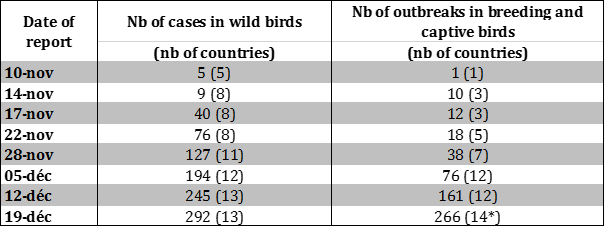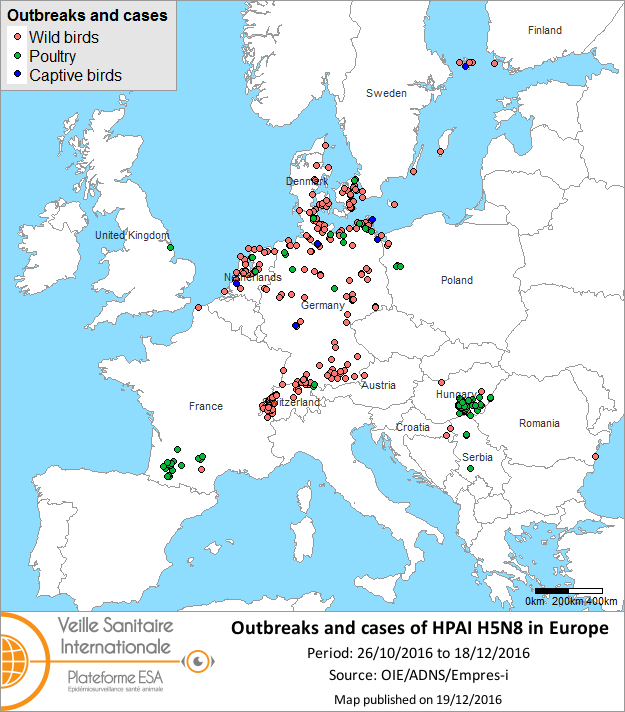Epidemiological situation of HPAI H5N8 in Europe since October 2016: situation as of 19th Dec 2016
International Animal Health Epidemic Intelligence (VSI) team – ESA Platform – France
NRL Avian Influenza, Anses laboratory Ploufragan – France
National Office for Hunting and Wildlife – France
Source: Data updated on 18 Dec 2016 (inclusive) ADNS/FAO/OIE/DGAL (General Directorate of Food – French Ministry of Agriculture)
This is a translation of a published report. The French version of this report is available here.
Since the last situation report on 12 Dec 2016, new HPAI H5N8 outbreaks were reported in Europe, mainly in Germany (120 cases in wild birds compared to 98 last week) and Hungary (201 farms compared to 120 last week). The United Kingdom declared its first outbreak on 17 Dec 2016 in Lincolnshire in a turkey farm, with a very high and surprising mortality (2,408 dead birds out of 2,428 in total, hence a 99% mortality rate). Poultry breeding sector is now affected in Serbia with a first outbreak reported on 15 Dec (species unspecified). The total number of outbreaks and cases reported in Europe continues to increase and is now 558 (compared to 406 last week), in which 292 were wild birds (53 species affected), 259 in farms, and 7 in captive birds. The increasing number of new outbreak declarations is causing a decrease in the amount of available information in ADNS alerts, such as affected species or number of cases/dead birds. However, this information can be found in FAO reports, hence the increase in number of wild bird species affected since last week considering this new data source in the present report.
The HPAI H5N8 situation in France is detailed in the website of the ESA Platform in reports from 16 Dec (link), 5 Dec (link), 2 Dec (link), and 30 Nov (link).
An interactive map of outbreaks and cases of HPAI H5N8 in Europe is also provided (link)
The HP H5N8 virus is also present beyond Europe. An outbreak of HPAI H5N8 was reported on 13 Nov 2016 in a poultry farm in Israel. Cases were also reported for the 1st time in Egypt on 30 Nov 2016 in 2 coots (Fulica atra), in Ukraine on 30 Nov 2016 in poultry (species unspecified), and in Tunisia on 1 Dec 2016 in 17 Eurasian coots (Fulica atra) and 13 Eurasian wigeons (Anas penelope). Iran identified 5 outbreaks in laying hens between 14 and 28 Nov 2016. The virus circulates also in Russia, with a reported case in avifauna in June 2016, 2 outbreaks declared on 13 poultry farms (geese, chickens and guinea fowls), and one outbreak reported on 8 Dec 2015 in a laying hen farm.
Table 1: Evolution of number of outbreaks and cases of HPAI H5N8 in the European Union and number of countries affected (in parentheses) declared from 26 Oct to 18 Dec 2016 (inclusive) (sources: OIE/ADNS/DGAL)
New countries since the last report for each category: * Serbia, United-Kingdom
Table 2: Number of outbreaks and cases of HPAI H5N8 in the European Union and Switzerland declared from 26 Oct to 18 Dec 2016 (inclusive) according to the type of birds affected (sources: OIE/ADNS/DGAL).
The mortality reported in farms is variable depending on the species, but also for a given species, and is calculated based on a limited number of outbreaks. For mono-species farms, the mortality varied from 0.3 to 33% in Gallus gallus farms, around 20 % in turkey farms (except for the UK outbreak with a 99% mortality rate), and from 0 to 70% in palmipeds. Despite a prudent interpretation (time of intervention in relation to infection, farms epidemiologically linked, which could be at the very beginning of infection, etc.), it should be noted that this strain appears to have an unusual virulence in breeding palmipeds.
The 53 different species of birds infected in the avifauna in Europe, with their families, are:
- Accipitridae: Eurasian Buzzard, Rough-legged Buzzard, White-tailed Eagle, Eagle spp, Northern goshawk
- Anatidae: Northern Pintail, Common Teal, Common Pochard, Tufted Duck, Common Goldeneye, Mallard, Eurasian wigeon, Gadwall, Whooper Swan, Mute Swan, Northern pintail, Greylag goose, Bean goose, White-fronted goose, Pink-footed goose, Greater scaup, Dark-bellied brant, Canada goose, Barnacle goose, Res-breasted goose, Black swan, Common Shelduck, Common Eider, Red-crested Pochard, Common Scoter, Common Merganser
- Ardeidae: Grey Heron
- Colombidae: Collared Dove
- Corvidae: Eurasian Magpie, Hooded Crow, Common Raven, Carrion Crow
- Dromaiidae: Emu
- Falconidae: Peregrine Falcon
- Laridae: Black-headed Gull, Huahine Gull, Herring Gull, Mew Gull, Great Black-backed Gull, Yellow-legged Gull
- Pelecanidae: Great white Pelican
- Phalacrocoracidae: Great Cormorant
- Podicipedidae: Great-crested Grebe, Little Grebe
- Rallidae: Common Moorhen, Eurasian Coot
- Scolopacidae: Curlew spp and Green Sandpiper
Figure 1: Outbreaks and cases of HPAI H5N8 declared in the European Union and Switzerland from 26 Oct to 18 Dec 2016 (inclusive) (sources: OIE/FAO/ADNS/DGAL).
The European Commission and the FAO are calling on Member States to reinforce and maintain vigilance for wild birds and poultry.
References:
- The Global Consortium for H5N8 and Related Influenza Viruses 2016. Role for migratory wild birds in the global spread of avian influenza H5N8, Science, 14 Oct 2016:Vol. 354, Issue 6309, pp. 213-217. DOI: 10.1126/science.aaf8852
- H5N8 highly pathogenic avian influenza (HPAI) of clade 2.3.4.4 detected through surveillance of wild migratory birds in the Tyva Republic, the Russian Federation – potential for international spread, Empreswatch septembre 2016
- EFSA, 2014. Highly pathogenic avian influenza A subtype H5N8. EFSA Journal 2014;12(12):3941, 32 pp. doi:10.2903/j.efsa.2014.3941
Previous reports:
- « Situation épidémiologique IAHP H5N8 en Europe depuis octobre 2016 : point de situation au 12/12/2016 » du 12/12/2016 (lien)
- « Situation épidémiologique IAHP H5N8 en Europe depuis octobre 2016 : point de situation au 05/12/2016 » du 05/12/2016 (lien)
- « Recrudescence de foyers d’IAHP H5N8 en Europe en octobre et novembre 2016 : actualisation au 28/11/2016 à 12h00 » du 28/11/2016 (lien)
- « Recrudescence de foyers d’IAHP H5N8 en Europe en octobre et novembre 2016 : actualisation au 22/11/2016 » du 24/11/2016 (lien)
- « Recrudescence de foyers d’IAHP H5N8 en Europe en octobre et novembre 2016 : actualisation au 17/11/2016 » du 17/11/2016 (lien)
- « Recrudescence de foyers d’IAHP H5N8 en Europe en octobre et novembre 2016 » du 10/11/2016 (lien)



